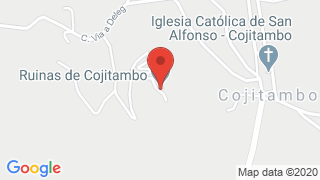Cojitambo Archaeological Complex


Cojitambo Archaeological Complex Description
The Cojitambo Archaeological Complex is located on the Cojitambo hill, 11 km away from Azogues canton. It is an extensive and impressive complex of ruins that rise on the mountainous summit at the north and west flanks of the hill, adapting to the morphological characteristics of the terrain.
Knowing this complex is a magical experience that will take you on a trip to the past, Cojitambo structures are a solid construction based on blocks edged with andesite rock, placed one upon another forming natural rows, joined with black earth mortar and filled with masonry. All these groups, which are complemented with other evidence of military and religious character, are articulated with the Inca's path that passes through the base of the hill, and that in the aboriginal era communicated the ancient Tomebamba with the manor Cañari de Peleusí.
The archaeological complex is quite extensive and has constructions with a level of complexity; due to that it has been divided into 3 architectural sets, depending on their spatial distribution and some features that differentiate the sectors from each other:
Set I: Which is made up of a large square with a central U-shaped usnu with round corners open to the east. The walls that make it up are 1.80 meters high by 1.53 meters thick, inside there is a circular water well lined with stone that measures 2.20 meters high by 1.80 meters in diameter. The well has a small staircase of three steps to descend and the usno a diagonal entrance of 3.35 meters wide that communicates with the access road.
Set II: Which consists of a large residential terrace, with a retaining wall, and two platforms with retaining walls, and two platforms with retaining walls in the lower part. It is flanked by two semi-elliptical housing bases, 10.50 meters long by 4.80 meters wide and 9.95 meters long by 3.15 meters wide respectively.
Set III: Which is formed by a rectangular structure of two environments, 6 platforms with retaining walls, 5 housing bases, 4 staircases and space delimited by a curved wall that covers an approximate area of 682.5 square meters, Square southeast. The rectangular structure is made of pirca and mud mortar, and is supported on a large terrace constructed artificially on the rock matrix of the hill. The largest relatively well preserved enclosure is 6.30 meters long by 4.50 meters wide, and the walls 2.20 meters high by 0.84 thick. The second smallest and least preserved enclosure is 3.35 meters long by 4.50 meters wide and the walls 0.64 meters thick, only have several rows of stone on its three sides and a door opening 0.90 meters wide on the wall north.
All these sets of stone structures and foundations cover an area of approximately 25 hectares, on the west side of the hill. In these sets there are:
-
- Next to the access road there are three rooms for lodging and administrative activities.
- A Kallanca type structure on a platform with a stone retaining wall, approximately one hectare in area.
- A series of circular collcas between the top of the hill and the wall at southeast.
- A set of several residential and cultivation terraces that follow each other in a staggered manner from the top to the base of the hill, on the north and west sides.
- The access road that ascends on the southwest front, with double retaining wall of stone and steps, in a length of 120 meters.
- An element known as the Mashojutcu (Cave of the bats), located on the east side of the hill, which is nothing more than a rocky shelter formed by the union of two huge blocks of andesite a few meters deep.
- All these structures, which are complemented with other evidence of military and religious character, are articulated with the Inca's path that passes through the base of the hill, and that in the aboriginal era communicated the ancient Tomebamba with the manor Cañari de Peleusí.
Cojitambo Archaeological Complex Location
-
- It is located 11 kilometers west from Azogues city, in the western foothills of the eponymous hill, in Cojitambo parish.
Cojitambo Archaeological Complex Extension
It has an area of approximately 25 hectares.
Cojitambo Archaeological Complex Construction Period
Enough evidence has been found in this complex to determine that the Cojitambo was inhabited during Regional Development Period (500 BC-500 AD), Integration Period (500-1460 AD) and Inca Period (1460-1532 AD ); since it has architectural features and cultural materials that denounce a very old occupation of the site.
Means of Access to Cojitambo
Intercantonal transport service, through the Pan-American Transport Cooperative, has its service station in the Terrestrial Terminal, located on Ernesto Che Guevara Avenue, the route is Azogues-Cojitambo-Déleg, offering its service every 15 minutes, tour time is 30 minutes, until the entrance to access the hill, ticket price 0.45 usd .; Children, students, seniors and disabled people pay 50%.
Nearby Attractions:
-
- Rock climbing.
- Qhapac Ñan.
- Summit of the hill.

Publicado en:
Publicado por:




